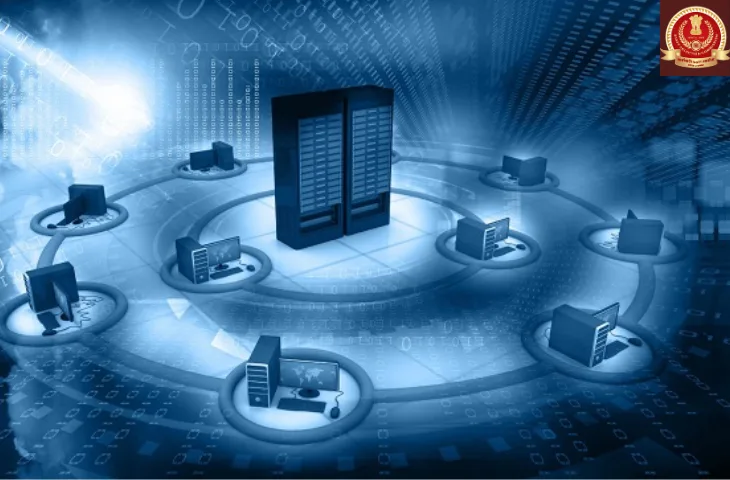Understanding networking devices and protocols is important for SSC CGL Tier 2, especially for questions in Computer Awareness. This blog covers the key devices, their functions, and common protocols in a simple way.
What is a Network?
A network is a system that connects two or more computers or devices to share resources like data, software, and internet. Networking is essential for communication in offices, schools, and organizations.
Types of Networks
Networks can be classified based on area and size:
- LAN (Local Area Network): Covers a small area like a building.
- WAN (Wide Area Network): Covers a large area like a city or country.
- MAN (Metropolitan Area Network): Covers a city or town.
- PAN (Personal Area Network): Covers a personal device area, like Bluetooth connections.
Networking Devices
Networking devices are used to connect computers and manage data transfer. Here are the key devices for SSC CGL Exam Tier 2:
| Device | Function | OSI Layer | Key Points |
| Hub | Connects multiple computers in a network. | Layer 1 – Physical Layer | Broadcasts data to all devices; least intelligent device. |
| Switch | Connects multiple devices and forwards data to the intended device only. | Layer 2 – Data Link Layer | More efficient than a hub; reduces data collisions. |
| Router | Connects different networks and routes data between them. | Layer 3 – Network Layer | Used to connect LAN with the Internet; makes routing decisions. |
| Modem | Converts digital signals to analog and vice versa. | — | Enables internet access over telephone lines; stands for Modulator-Demodulator. |
| Access Point (AP) | Provides wireless access to a network. | Layer 2 – Data Link Layer | Connects Wi-Fi-enabled devices to a wired LAN. |
| Repeater | Strengthens and extends the range of network signals. | Layer 1 – Physical Layer | Used to regenerate weak signals over long distances. |
| Firewall | Monitors and controls network traffic for security. | Layer 3 & above | Protects network from unauthorized access and threats. |
Also check out: SSC CGL Typing Test Errors to minimize your errors in Data Entry Speed Test.
Networking Protocols
Protocols are rules that define how data is transmitted over a network. Common protocols for SSC CGL Tier 2 include:
| Protocol | Full Form | Function |
| TCP | Transmission Control Protocol | Ensures reliable data transfer |
| IP | Internet Protocol | Routes data packets across networks |
| HTTP | HyperText Transfer Protocol | Used to browse websites |
| HTTPS | HyperText Transfer Protocol Secure | Secure browsing using encryption |
| FTP | File Transfer Protocol | Transfers files between computers |
| SMTP | Simple Mail Transfer Protocol | Sends emails |
| POP3 | Post Office Protocol | Receives emails |
| DHCP | Dynamic Host Configuration Protocol | Assigns IP addresses automatically |
| DNS | Domain Name System | Converts domain names into IP addresses |
Key Takeaways:
Below are the key takeaways:
- Hub, switch, and router are common networking devices.
- TCP/IP is the backbone protocol for the Internet.
- HTTP/HTTPS are widely asked in SSC CGL computer awareness.
- Understanding OSI layers helps in solving networking questions.
- Firewalls and access points are important for security and wireless networks.
FAQs
Ans. A router connects different networks and routes data packets between them. It works at the Network Layer (Layer 3) of the OSI model.
Ans. Devices like Hub and Repeater operate at the Physical Layer (Layer 1).
Ans. A hub broadcasts data to all connected devices, while a switch sends data only to the intended device, making it more efficient.
Ans. A modem converts digital signals to analog and vice versa, allowing internet connectivity through telephone lines.
Ans. A firewall monitors and controls network traffic to protect systems from unauthorized access and cyber threats.
- SSC CGL 2025 Tier 1 PYPs, Shift-Wise Previous Papers, Download PDFs
- SSC CGL Tier 2 Paper 1 Preparation Tips, Check now
- SSC CGL टॉप 5 हाई पेइंग जॉब्स कौन-सी हैं?, पूरी जानकारी यहां
- SSC CGL की तैयारी के लिए सबसे अच्छी किताबें कौन-सी हैं? यहां चेक करें
- SSC CGL पोस्ट प्रेफरेंस, SSC CGL की सबसे अच्छी पोस्ट क्या है?
- SSC CGL के लिए योग्यता क्या है? आयु सीमा, शिक्षा, शारीरिक मापदंड और अधिक

I’m Mahima Khurana, a writer with a strong passion for creating meaningful, learner-focused content especially in the field of competitive exam preparation. From authoring books and developing thousands of practice questions to crafting articles and study material, I specialize in transforming complex exam-related topics into clear, engaging, and accessible content. I have first hand experience of 5+ months in SSC Exams. Writing, for me, is not just a skill but a way to support and guide aspirants through their preparation journey one well-written explanation at a time.
